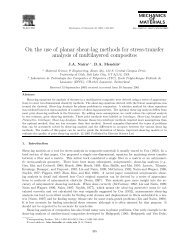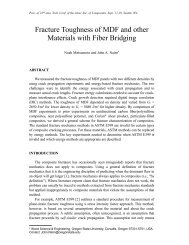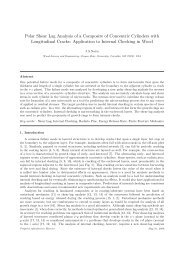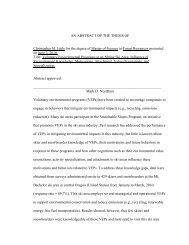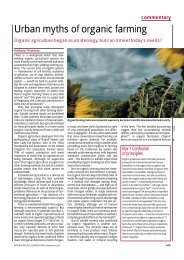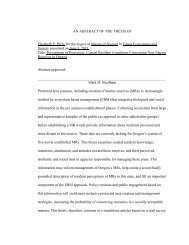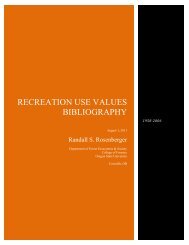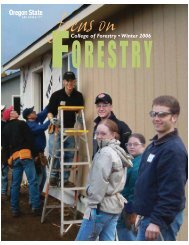College of Forestry - Oregon State University
College of Forestry - Oregon State University
College of Forestry - Oregon State University
Create successful ePaper yourself
Turn your PDF publications into a flip-book with our unique Google optimized e-Paper software.
From the Dean<br />
<strong>College</strong> <strong>of</strong> <strong>Forestry</strong> Annual Report 2005-2006<br />
I<br />
look at 2006 as a pivotal year<br />
for the <strong>College</strong> <strong>of</strong> <strong>Forestry</strong><br />
and <strong>Oregon</strong> Forest Research<br />
Laboratory. In 1906, <strong>Forestry</strong><br />
was introduced as a degree<br />
program at the <strong>Oregon</strong> Agricultural<br />
<strong>College</strong>. Before this, our timberlands<br />
were subjected to logging and lumber<br />
milling without much concern for the<br />
environment or the future. <strong>Forestry</strong><br />
and forest products processing in<br />
America have evolved and changed<br />
dramatically over the past 100 years,<br />
providing the solutions to deforestation,<br />
resource waste, and land abuse.<br />
Over the years, the faculty, scientists,<br />
and graduates <strong>of</strong> this institution<br />
have contributed new knowledge and<br />
technologies, policy guidelines, and management insights to provide continual<br />
improvements and constant innovation. As a result <strong>of</strong> what we do at OSU,<br />
<strong>Oregon</strong>’s forests are among the best in the world for supporting multiple and<br />
sustainable values to the citizenry in all areas <strong>of</strong> the state. These forestlands<br />
provide an economic base for much <strong>of</strong> the state—$13 billion in direct economic<br />
impact and employment. These same lands provide recreational and social<br />
value to <strong>Oregon</strong>ians. Forests are also a key component in a complex ecological<br />
system that is crucial to our water, air, and climate. I view the outstanding<br />
efforts <strong>of</strong> our faculty and scientists as crucial to sustaining the multiple values <strong>of</strong><br />
forests. This annual report highlights the most recent installment to a Legacy <strong>of</strong><br />
Excellence.<br />
Forest products manufacturing has also seen marked advances in the past<br />
100 years. Wood products are vital to the quality <strong>of</strong> every <strong>Oregon</strong>ian’s life. They<br />
are in our houses, our toothpaste, some <strong>of</strong> our clothes, and countless products<br />
we would never suspect <strong>of</strong> having cellulosic components. Innovations in<br />
milling, manufacturing, and new products have greatly improved utilization<br />
efficiency while innovations in use <strong>of</strong> wood products have increased durability<br />
and life span. Many <strong>of</strong> these innovations came from OSU researchers. Collectively,<br />
they mean that people get a lot more value from each tree harvested than<br />
they did 50 years ago.<br />
1932<br />
Mary McDonald donates<br />
McDonald Forest.<br />
1933<br />
The Civilian Conservation<br />
Corps (CCC) establishes<br />
Camp<br />
Arboretum.<br />
1934<br />
Dean Peavy is appointed president <strong>of</strong> <strong>Oregon</strong> <strong>State</strong><br />
<strong>College</strong>. Mary J. L. McDonald Collection and Rare Book<br />
Room is presented to <strong>Oregon</strong> <strong>State</strong> <strong>College</strong>.<br />
1937<br />
“Foresters in Action” radio<br />
show broadcasts weekly<br />
over KOAC.





